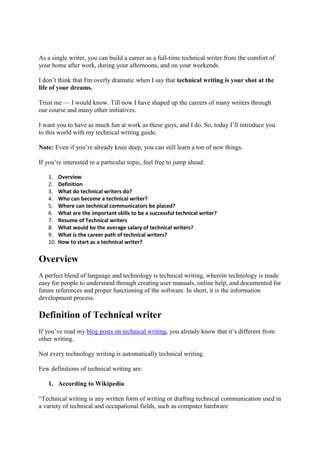Being a top-notch developer was my dream – until I realized I could combine my passion for writing with my technical knowledge to earn a living. That's right: I'm talking about becoming a technical writer. And if you're a developer, you may be in a good position to get into technical writing if it's something that interests you. Developers have a lot of knowledge about topics like Git, Markdown, programming languages, and IDEs that they can use to teach others. And since they have worked with these tools and technologies themselves, they can often write documentation with a user-centric approach. It's also fairly lucrative to be a technical writer, with the average salary in the US being $76,432 per year. This makes it a viable career to support yourself and your family. How to Become a Technical Writer – A Guide for Developers create by Md Jewel Hossain (Developerjewelbd)
Luckily, I had technical writing samples to exhibit my writing skills when I decided to give it a chance. My love for writing offered me a ready-made technical writing portfolio and made my career change easier. But this is not the case for everyone and people regularly ask me tips to start technical writing and earn through it. So I'm compiling all the things that helped me transition into technical writing in this article. Being a top-notch developer was my dream – until I realized I could combine my passion for writing with my technical knowledge to earn a living. That's right: How to Become a Technical Writer – A Guide for Developers create by Developerjewelbd
What is Technical Writing?

Technical writing typically involves breaking down complex technical knowledge into simple words, making it easier for a non-technical audience to grasp technical concepts. This can include writing user manuals, API documentation, online help, how-to guides, and other types of content that help people understand and use a product or service. How to Become a Technical Writer – A Guide for Developers create by Md Jewel Hossain (Developerjewelbd)
Technical writers work in a variety of industries, from software and technology to healthcare and manufacturing. They may work for large companies, small startups, or even as freelancers. The goal of a technical writer is to take complex information and present it in a clear, concise, and easy-to-understand way.
Characteristics of Technical Writing
Technical writing has several key characteristics that set it apart from other types of writing:
- Audience-Focused: Technical writing is focused on the needs and understanding of the target audience. The writer must consider the reader's level of technical knowledge and tailor the content accordingly.
- Clarity and Precision: Technical writing must be clear, concise, and accurate. There is no room for ambiguity or vagueness, as the information needs to be easily understood.
- Objectivity: Technical writing should be objective and free of personal opinions or biases. The focus should be on presenting the facts and information.
- Organization and Structure: Technical writing often follows a specific structure and format, such as step-by-step instructions or a hierarchical layout.
- Use of Visual Aids: Technical writing frequently incorporates visual aids, such as diagrams, illustrations, and screenshots, to help explain complex concepts.
Types of Technical Writing
There are several common types of technical writing that you might encounter as a technical writer:
- User Manuals: These documents provide instructions on how to use a product or service, often with step-by-step guides and troubleshooting information.
- API Documentation: This type of writing explains how to use an application programming interface (API), including information on available functions, parameters, and examples.
- Online Help: Online help systems provide interactive, context-sensitive assistance to users within a software application or website.
- How-to Guides: These step-by-step instructions help users accomplish a specific task or solve a problem.
- Product Specifications: These documents outline the features, capabilities, and technical details of a product.
- Software Documentation: This includes a wide range of documentation, such as installation guides, release notes, and developer documentation.
- Technical Reports: These reports present the findings of technical research or analysis, often for a specific audience.
What are the Responsibilities of a Technical Writer?

The responsibilities of a technical writer can vary depending on the specific role and industry, but there are some common tasks and duties that are often expected: How to Become a Technical Writer – A Guide for Developers create by Md Jewel Hossain (Developerjewelbd)
1. Gather and Understand Technical Information
Technical writers need to have a solid understanding of the technical topics they are writing about. This often involves researching and interviewing subject matter experts to gather the necessary information.
Conducting Research
Technical writers must be skilled at researching and gathering information from a variety of sources, such as:
- Product specifications and design documents
- Interviews with engineers, developers, and other subject matter experts
- User manuals, tutorials, and other existing documentation
- Online resources, such as forums, blogs, and technical references
Comprehending Technical Concepts
Once the information is gathered, technical writers need to understand the technical concepts and be able to explain them in a clear and accessible way. This may involve:
- Asking clarifying questions to ensure understanding
- Familiarizing themselves with the product, technology, or process
- Learning relevant technical terminology and jargon
2. Organize and Structure Content
Technical writing often involves structuring complex information in a logical and intuitive way. This includes:
Determining the Appropriate Structure
Technical writers must decide on the most effective way to organize the content, such as:
- Hierarchical structures (e.g., chapters, sections, subsections)
- Procedural formats (e.g., step-by-step instructions)
- Modular designs (e.g., separate documents for different tasks or features)
Ensuring Coherence and Flow
The content must be structured in a way that makes it easy for the reader to understand and follow. This may involve:
- Defining clear objectives and goals for the documentation
- Organizing information in a logical and intuitive sequence
- Using consistent formatting, terminology, and style throughout
3. Create Clear and Concise Content
The primary responsibility of a technical writer is to create documentation that is easy to understand and use. This involves:
Writing in a Clear and Accessible Style
Technical writers must be able to translate complex technical information into language that is easy for the target audience to comprehend. This may include:
- Using simple, straightforward language
- Avoiding jargon and technical terminology where possible
- Providing clear and concise explanations of concepts and processes
Incorporating Visual Elements
Technical writers often use visual aids, such as diagrams, screenshots, and tables, to enhance the clarity and comprehension of the content. These visual elements can help to: How to Become a Technical Writer – A Guide for Developers create by Md Jewel Hossain (Developerjewelbd)
- Illustrate complex processes or systems
- Simplify the presentation of technical data
- Provide a more engaging and user-friendly reading experience
4. Review and Revise Content
Technical writing is an iterative process, and technical writers must be prepared to review and revise their work multiple times. This includes:
Proofreading and Editing
Technical writers must carefully review their work to ensure there are no errors or inconsistencies in the content, such as:
- Grammatical and spelling errors
- Incorrect or outdated information
- Inconsistencies in formatting or terminology
Incorporating Feedback
Technical writers must be open to feedback and suggestions from subject matter experts, editors, and end-users, and be willing to make revisions based on that feedback. This helps to ensure the content is as accurate, clear, and user-friendly as possible.
5. Collaborate with Cross-Functional Teams
Technical writers often work closely with other members of the organization, such as:
Subject Matter Experts
Technical writers must collaborate with engineers, developers, and other subject matter experts to ensure the accuracy and completeness of the technical information being documented.
Editors and Designers
Technical writers may work with editors and graphic designers to ensure the content is well-written, visually appealing, and aligned with the organization's branding and style guidelines.
End-Users
Technical writers may receive feedback and input from the end-users of the documentation, which can help to identify areas for improvement and ensure the content is meeting their needs.
By working closely with these cross-functional teams, technical writers can create high-quality, user-friendly documentation that meets the organization's and its customers' needs.
Build a Portfolio

Building a strong portfolio of technical writing samples is essential when trying to break into the field of technical writing. A portfolio showcases your writing skills, your ability to break down complex information, and your experience with different types of technical documentation.
Why a Portfolio is Important
A portfolio is important for several reasons:
- Demonstrates Your Skills: A portfolio allows you to showcase your technical writing skills, including your ability to write clearly, concisely, and accurately, as well as your proficiency in using various formatting and design elements.
- Provides Relevant Samples: A portfolio gives potential employers or clients a tangible way to assess your writing abilities and see the types of technical documents you have produced.
- Sets You Apart: In a competitive job market, a well-crafted portfolio can help you stand out from other applicants and demonstrate your commitment to the field of technical writing.
- Helps You Land Interviews: A strong portfolio can help you get your foot in the door and secure interviews for technical writing roles, as it gives employers a preview of your skills and abilities.
What to Include in Your Portfolio
Your technical writing portfolio should include a variety of samples that showcase your skills and experience. Some examples of what to include are:
- User Manuals: Demonstrate your ability to create clear, step-by-step instructions for using a product or service.
- API Documentation: Showcase your ability to explain complex technical concepts and APIs in an easy-to-understand way.
- Online Help Content: Include samples of your work creating interactive help content for software applications or websites.
- How-to Guides: Demonstrate your ability to break down complex tasks into simple, actionable steps.
- Product Specifications: Include samples of your work documenting the technical details and features of a product.
- Technical Reports: Showcase your ability to research, analyze, and present technical information in a formal report format.
- Sample Projects: If you don't have professional experience, consider including sample projects you've completed during your studies or personal pursuits.
When selecting samples for your portfolio, choose pieces that best represent your writing skills, technical expertise, and the types of documents you are interested in creating. It's also important to ensure that the content is well-written, visually appealing, and easy to understand.
How to Organize Your Portfolio
When putting together your technical writing portfolio, consider organizing it in a way that makes it easy for potential employers or clients to navigate and understand your capabilities. Here are some tips:
- Create a Table of Contents: Include a clear table of contents that lists the different types of documents in your portfolio and provides brief descriptions of each.
- Use Consistent Formatting: Ensure that all of the documents in your portfolio use a consistent format, font, and style to create a cohesive and professional look.
- Include Contextual Information: For each sample, provide a brief overview that explains the purpose of the document, the target audience, and any relevant constraints or requirements.
- Showcase a Variety of Skills: Try to include a diverse range of samples that demonstrate your ability to handle different types of technical writing tasks, from user manuals to API documentation.
- Make it Easy to Navigate: Consider using tabs, dividers, or other organizational tools to make it easy for the reader to quickly find and review the samples they are most interested in.
- Maintain a Digital Version: In addition to a physical portfolio, it's a good idea to maintain a digital version that you can easily share with potential employers or clients.
By creating a well-organized and comprehensive portfolio, you can effectively showcase your technical writing skills and increase your chances of landing your first (or next) technical writing role.
Upskill to Documentation Writing

As a developer, you may already have a strong foundation in technical knowledge and writing skills. However, to transition into a successful technical writing career, you'll need to develop additional skills and knowledge specific to the field of documentation writing.
Develop Strong Writing Skills
While developers may be skilled in writing code and technical documentation, the art of technical writing for a non-technical audience requires a different set of skills. To become a proficient technical writer, you should focus on:
- Clear and Concise Writing: Develop the ability to explain complex technical concepts in a simple, easy-to-understand way, using plain language and avoiding jargon.
- Audience-Focused Writing: Learn to tailor your writing to the specific needs and level of understanding of your target audience.
- Structuring and Organizing Content: Develop the skills to organize information in a logical and intuitive way, using headings, subheadings, and other formatting techniques to improve readability.
- Editing and Proofreading: Hone your editing and proofreading skills to ensure your writing is free of errors and typos.
Familiarize Yourself with Documentation Tools
Technical writers often use a variety of tools to create, manage, and publish documentation. Some common tools include:
- Markdown: Learn how to use Markdown, a lightweight markup language, to format your writing for easy publishing.
- Content Management Systems (CMS): Become familiar with CMS platforms like Confluence, Drupal, or WordPress, which are often used to host and manage technical documentation.
- Authoring Tools: Explore tools like MadCap Flare, Adobe FrameMaker, or Microsoft Word, which are specifically designed for creating and managing technical documentation.
- Version Control: Understand how to use version control systems like Git to collaborate on and manage documentation projects.
Develop Contextual Knowledge
As a technical writer, you'll need to have a deep understanding of the products, technologies, and processes you're writing about. This may involve:
- Researching and Exploring: Dive into the technical details of the products or services you'll be documenting, and familiarize yourself with the relevant technologies and industry-specific terminology.
- Collaborating with Subject Matter Experts: Work closely with engineers, developers, and other subject matter experts to gain a deeper understanding of the technical concepts and requirements.
- Staying Up-to-Date: Continuously educate yourself on the latest industry trends, technologies, and best practices to ensure your documentation remains relevant and accurate.
Enhance Your Multimedia Skills
In addition to strong writing skills, technical writers often need to create or incorporate various types of multimedia content, such as:
- Screenshots and Images: Learn how to capture, edit, and annotate screenshots and images to effectively illustrate your documentation.
- Videos and Animations: Consider developing skills in creating instructional videos or animated tutorials to complement your written content.
- Diagrams and Infographics: Familiarize yourself with tools and techniques for creating clear, visually appealing diagrams and infographics to explain complex technical concepts.
By continuously upskilling and developing these key competencies, you can position yourself as a well-rounded and highly sought-after technical writer in the job market.
Find Paid Projects

Once you've built a portfolio and honed your technical writing skills, the next step is to find paid projects and start earning as a technical writer. Here are some strategies to help you find and land paid technical writing work:
Freelance Platforms
One of the easiest ways to find paid technical writing projects is to explore freelance platforms like Upwork, Fiverr, or Freelancer.com. These platforms allow you to create a profile, showcase your portfolio, and bid on a wide range of technical writing jobs, including:
- User manuals
- API documentation
- Software tutorials
- Knowledge base articles
- Product specifications
To be successful on these platforms, make sure to:
- Craft a compelling profile that highlights your technical writing skills and experience.
- Carefully review job postings and submit proposals that demonstrate your understanding of the project requirements.
- Provide high-quality samples of your work to showcase your abilities.
- Maintain a positive reputation by delivering projects on time and to the client's satisfaction.
Job Boards
In addition to freelance platforms, you can also find technical writing job postings on traditional job boards, such as:
- LinkedIn Jobs
- Indeed
- Monster
- SimplyHired
When searching for technical writing jobs on these platforms, try using keywords like "technical writer," "documentation specialist," or "content writer" to find relevant listings.
Networking and Referrals
Networking and building relationships within the technical writing community can be a powerful way to find paid projects. Consider:
- Joining local or online technical writing groups and engaging with other professionals.
- Attending industry events, conferences, or meetups to connect with potential clients or employers.
- Leveraging your existing network of developers, engineers, and other professionals who may be able to refer you to technical writing opportunities.
Contacting Companies Directly
Another strategy is to reach out to companies directly and inquire about technical writing opportunities. This could involve:
- Identifying companies in your target industry that may have a need for technical writers.
- Researching the company's products, services, and documentation needs.
- Crafting a personalized pitch that highlights your relevant skills and experience.
- Sending a cover letter and resume directly to the appropriate hiring manager or department.
Freelancing Websites
In addition to freelance platforms, there are also dedicated freelancing websites that focus on technical writing and documentation, such as:
- Technical Writers HQ
- Doc Ops
- Technical Writing World
These websites often have job boards or directories where you can browse and apply for technical writing projects.
By using a combination of these strategies, you can increase your chances of finding paid technical writing projects and start building your career as a successful technical writer.
How to Learn the Skills for Technical Writing

If you're interested in becoming a technical writer but don't have a lot of prior experience, don't worry! There are many ways youcan learn the skills needed to succeed in this field. Here are some strategies to help you kickstart your journey into technical writing:
Online Courses and Tutorials
Taking online courses and tutorials is a great way to learn the fundamentals of technical writing at your own pace. Platforms like Coursera, Udemy, and LinkedIn Learning offer a wide range of courses on topics such as:
- Technical writing basics
- Document design and formatting
- Writing for different audiences
- Creating user guides and manuals
These courses often include hands-on assignments and projects to help you practice your skills.
Books and Resources
There are many books and resources available that can provide valuable insights into the world of technical writing. Some recommended reads include:
- "Technical Writing Process: The Simple, Five-Step Guide That Anyone Can Use to Create Technical Documents Such as User Guides, Manuals, and Procedures" by Kieran Morgan
- "The Insider's Guide to Technical Writing" by Krista Van Laan
- "Technical Writing 101: A Real-World Guide to Planning and Writing Technical Content" by Alan S. Pringle and Sarah S. O'Keefe
These resources cover essential topics such as audience analysis, document planning, and writing style.
Practice Projects
One of the best ways to learn technical writing is through hands-on practice. Consider taking on volunteer projects, such as contributing to open-source documentation or creating user guides for software applications. This will not only help you build your portfolio but also give you real-world experience in writing technical content.
Mentorship and Networking
Seeking mentorship from experienced technical writers can provide valuable guidance and insights as you navigate your career path. Connect with professionals in the field through online forums, social media platforms like LinkedIn, or local meetups. Building a strong network can open doors to opportunities and help you stay informed about industry trends.
Formal Education
If you're looking to pursue technical writing as a long-term career, consider enrolling in a formal degree program or certification course in technical communication or professional writing. Many universities offer programs specifically tailored to aspiring technical writers, providing in-depth knowledge and practical skills that can set you apart in the job market.
By combining these learning strategies and continuously honing your skills, you can develop the expertise and confidence needed to excel as a technical writer.
Conclusion


Becoming a successful technical writer requires a combination of specialized skills, industry knowledge, and a passion for clear communication. By understanding the role of a technical writer, building a strong portfolio, upskilling in documentation writing, finding paid projects, and continuously learning and improving your skills, you can carve out a rewarding career in this dynamic field.
Remember, technical writing is not just about conveying information—it's about creating valuable content that helps users understand complex concepts and accomplish their goals. With dedication, perseverance, and a commitment to excellence, you can thrive as a technical writer and make a significant impact in the tech industry.
How to Become a Technical Writer – A Guide for Developers

Technical writing is a specialized form of communication that conveys complex information in a clear and concise manner. As a technical writer, your primary responsibility is to create documentation that helps users understand how to use a product or service effectively. This guide will walk you through the essential steps to kickstart your career as a technical writer.
What is Technical Writing?

Technical writing involves creating documents such as user guides, manuals, tutorials, and online help systems that explain how to use software, hardware, or other technical products. The goal of technical writing is to make complex information accessible to a specific audience, often non-technical users.
One key aspect of technical writing is understanding the target audience and tailoring the content to their needs and knowledge level. Technical writers must also have a strong attention to detail, excellent research skills, and the ability to organize information logically.
What are the Responsibilities of a Technical Writer?
The responsibilities of a technical writer may vary depending on the industry and organization, but some common tasks include:
- Researching and gathering information from subject matter experts.
- Organizing and structuring content in a logical way.
- Writing clear and concise documentation that is easy to understand.
- Collaborating with designers and developers to ensure accuracy and consistency.
- Updating and maintaining existing documentation as needed.
Technical writers play a crucial role in ensuring that users can effectively engage with a product or service by providing them with the information they need to troubleshoot issues, learn new features, and maximize their overall experience.
Build a Portfolio

Building a strong portfolio is essential for showcasing your technical writing skills to potential clients or employers. Your portfolio should include a variety of samples that demonstrate your ability to create different types of technical documentation, such as user guides, FAQs, or instructional videos.
When creating your portfolio, consider including:
- Samples that showcase your writing style and ability to convey complex information clearly.
- Projects that highlight your experience with different tools and technologies.
- Testimonials or recommendations from previous clients or colleagues.
A compelling portfolio can set you apart from other candidates and demonstrate your expertise in technical writing.
Upskill to Documentation Writing

To excel as a technical writer, it's important to upskill in documentation writing techniques and tools. Some key areas to focus on include:
- Learning how to use documentation tools such as Adobe FrameMaker, MadCap Flare, or Microsoft Word.
- Understanding best practices for creating user-friendly interfaces and layouts.
- Mastering version control systems like Git for managing documentation revisions.
- Familiarizing yourself with style guides and industry standards for technical writing.
By honing your skills in documentation writing, you can produce high-quality content that meets the needs of both users and stakeholders.
Find Paid Projects

Once you have built a solid portfolio and upskilled in documentation writing, it's time to start finding paid projects as a technical writer. There are several strategies you can use to secure paid opportunities:
Job Boards
In addition to freelance platforms, you can also find technical writing job postings on traditional job boards, such as:
- LinkedIn Jobs
- Indeed
- Monster
- SimplyHired
When searching for technical writing jobs on these platforms, try using keywords like "technical writer," "documentation specialist," or "content writer" to find relevant listings.
Networking and Referrals
Networking and building relationships within the technical writing community can be a powerful way to find paid projects. Consider:
- Joining local or online technical writing groups and engaging with other professionals.
- Attending industry events, conferences, or meetups to connect with potential clients or employers.
- Leveraging your existing network of developers, engineers, and other professionals who may be able to refer you to technical writing opportunities.
Contacting Companies Directly
Another strategy is to reach out to companies directly and inquire about technical writing opportunities. This could involve:
- Identifying companies in your target industry that may have a need for technical writers.
- Researching the company's products, services, and documentation needs.
- Crafting a personalized pitch that highlights your relevant skills and experience.
- Sending a cover letter and resume directly to the appropriate hiring manager or department.
Freelancing Websites
In addition to freelance platforms, there are also dedicated freelancing websites that focus on technical writing and documentation, such as:
- Technical Writers HQ
- Doc Ops
- Technical Writing World
These websites often have job boards or directories where you can browse and apply for technical writing projects.
By using a combination of these strategies, you can increase your chances of finding paid technical writing projects and start building your career as a successful technical writer.
How to Learn the Skills for Technical Writing

If you're interested in becoming a technical writer but don't have a lot of prior experience, don't worry! There are many ways you can learn the skills needed to succeed in this field. Here are some strategies to help you kickstart your journey into technical writing:
Online Courses and Tutorials
Taking online courses and tutorials is a great way to learn the fundamentals of technical writing at your own pace. Platforms like Coursera, Udemy, and LinkedIn Learning offer a wide range of courses on topics such as:
- Technical writing basics
- Document design and formatting
- Writing for different audiences
- Creating user guides and manuals
These courses often include hands-on assignments and projects to help you practice your skills.
Books and Resources
There are many books and resources available that can provide valuable insights into the world of technical writing. Some recommended reads include:
- "Technical Writing Process: The Simple, Five-Step Guide That Anyone Can Use to Create Technical Documents Such as User Guides, Manuals, and Procedures" by Kieran Morgan
- "The Insider's Guide to Technical Writing" by Krista Van Laan
- "Technical Writing 101: A Real-World Guide to Planning and Writing Technical Content" by Alan S. Pringle and Sarah S. O'Keefe
These resources cover essential topics such as audience analysis, document planning, and writing style.
Practice Projects
One of the best ways to learn technical writing is through hands-on practice. Consider taking on volunteer projects, such as contributing to open-source documentation or creating user guides for software applications. This will not only help you build your portfolio but also give you real-world experience in writing technical content.
Mentorship and Networking
Seeking mentorship from experienced technical writers can provide valuable guidance and insights as you navigate your career path. Connect with professionals in the field through online forums, social media platforms like LinkedIn, or local meetups. Building a strong network can open doors to opportunities and help you stay informed about industry trends.
Formal Education
If you're looking to pursue technical writing as a long-term career, consider enrolling in a formal degree program or certification course in technical communication or professional writing. Many universities offer programs specifically tailored to aspiring technical writers, providing in-depth knowledge and practical skills that can set you apart in the job market.
By combining these learning strategies and continuously honing your skills, you can develop the expertise and confidence needed to excel as a technical writer.
Conclusion

Becoming a successful technical writer requires a combination of specialized skills, industry knowledge, and a passion for clear communication. By understanding the role of a technical writer, building a strong portfolio, upskilling in documentation writing, finding paid projects, and continuously learning and improving your skills, you can carve out a rewarding career in this dynamic field.
Remember, technical writing is not just about conveying information—it's about creating valuable content that helps users understand complex concepts and accomplish their goals. With dedication, perseverance, and a commitment to excellence, you can thrive as a technical writer and make a significant impact in the tech industry.
To succeed as a technical writer, remember to:
- Create a compelling profile that highlights your technical writing skills and experience.
- Carefully review job postings and submit proposals that demonstrate your understanding of the project requirements.
- Provide high-quality samples of your work to showcase your abilities.
- Maintain a positive reputation by delivering projects on time and to the client's satisfaction.

